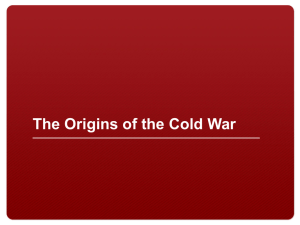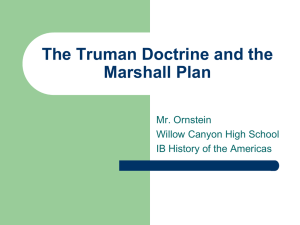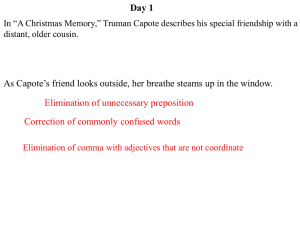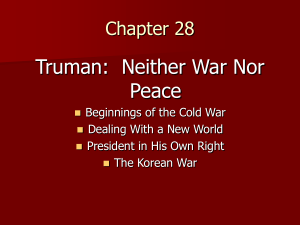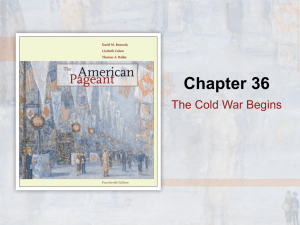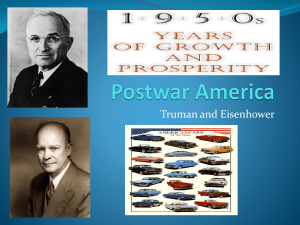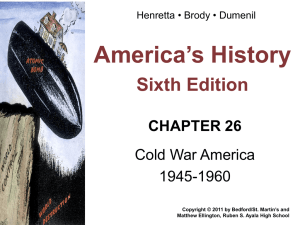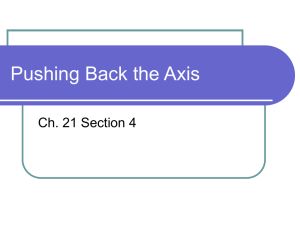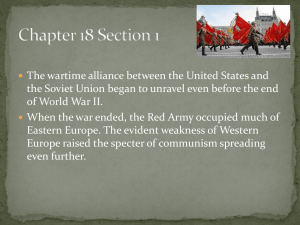The Truman Show
advertisement
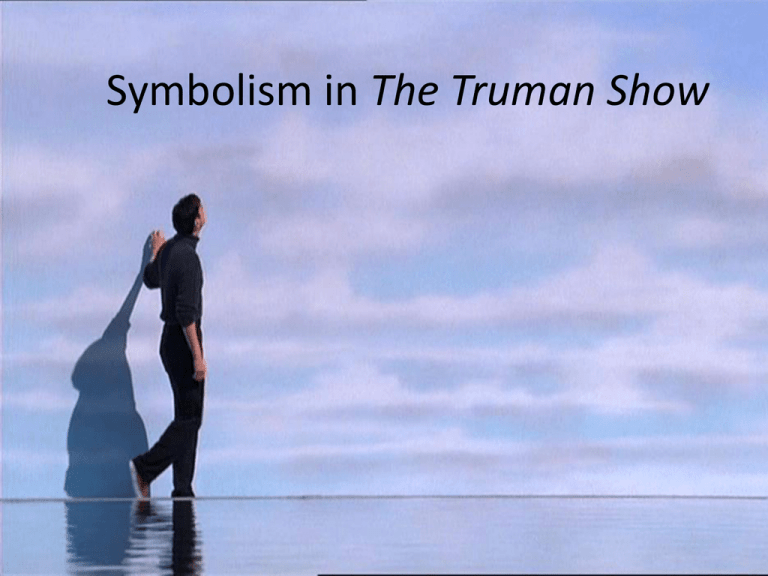
Symbolism in The Truman Show • Truman • He is the 'true man' – the only real person in Seahaven (apart from Sylvia briefly) – and as such symbolises 'Everyman'. He is a person to relate to rather than laugh at. He symbolises humanity's fundamental disposition for goodness and decency. • Sylvia • She represents truth – she tells Truman that the world he knows is a lie. She is the only character whose affection for him is genuine and without selfinterest, and as such represents real love, one of the highest states of human goodness, in contrast with the faked love of Meryl and Marlon. • Christof • ego, power and the abuse of power • More specifically, he symbolises the giant media companies, news organisations, and media-politicians that have a stake in keeping us surrounded by falsehood and offer rewards to keep us enslaved. • Christof is also a form of Christopher, which means Christ-bearer; in the Catholic tradition, he bears up travellers in the name of Christ. In a religious interpretation of the film, he can be seen as an 'off-Christ', a sort of antichrist or parody of Christ (Lucifer). Or on other levels, a megalomaniacal Hollywood producer, or just an overbearing parent • Fiji • an idealised alternative to Truman's stifling home, it focuses the two great desires for Truman: adventure and exploring the unknown, and Sylvia. To him it symbolises freedom to be himself. • Seahaven • the illusionary human-made Paradise; symbolises the comfortable prisons people make for themselves (their 'comfort zone') • the moon • a metaphor for the all-seeing, all-knowing control: cf 'Big Brother is watching you' (1984), or the 'Eye' in The Handmaid's Tale. • eyes • true love and truth; it is significant that Truman and Sylvia first connect by look rather than words; in the library, she says she is not supposed to talk to him, and writes "Now" on paper for him to read. • Bible: 'The light of the body is in the eye.' [Matthew 6, 22] • Cicero: 'The face is a picture of the mind as the eyes are its interpreter.' • Hegel: 'through the eyes we look into a man's soul.' • the French say, 'The eyes are the mirror of the soul.' • • • • • • • • • • the sea A complex symbol. Traditionally symbolises birth; water is associated with rebirth (baptism). Truman seems to die in the storm but is 'reborn' stronger than ever. The sea literally and metaphorically keeps Truman imprisoned. Because of the 'death' of his father, to him it means chaos, separation and death. It is Truman's greatest fear – and it is this fear he must overcome before he can be reborn as a new person in the real world. On an allegorical level, the sea can be seen to be a manifestation of the fear of the unknown, the barrier to new experience. It is not till Truman manages to cross the sea unaided – the first attempt with Meryl's help was foiled – that he is able to escape his prison. the yacht the symbol of freedom and Truman's urge to explore; it has the same name – Santa Maria – as one of Christopher Columbus's ships when he set off to discover the new world. the wall of the dome Literally the edge of his known world, it is the physical limitation he must find a way through. It provides a vivid metaphor for the fakery of Seahaven – it looks like the sky but is a plaster wall. On an allegorical level, it represents the barriers anyone faces in pursuit of selfactualisation. The boat that represents Truman's freedom is juxtaposed with the wall that limits it: a powerful image. When the bowsprit of the yacht pierces the fragile shell of Truman’s artificial world, Truman literally touches the limits of his universe. The illusion of what until that moment constituted his world is shattered. • the library • symbol of the knowledge of good and evil – Truman falls in love in a library. (It is the only place in Seahaven where there seem to be any books; knowledge and enquiry are not encouraged in this place. • the falling light • a visual pun as well as a metaphor for enlightenment; it is after the light falls, that Truman 'sees the light' • the revolving door • an important metaphor for indicating the change of direction Truman makes; when he chooses to go out the door again, he breaks with his conventional and routine life and begins the journey to the truth • the false elevator • a metaphor for the world of Seahaven – all surface, no reality. Look behind the façade and find – actors. • the trunk of memorabilia • Truman keeps it locked; it is full of his memories and secrets. It is his mind, his one vestige of privacy; the lock is a metaphor for the way he keeps his real self secret. "You never had a camera in my head," he tells Christof. • the photo album • if his trunk is a metaphor for Truman's private thoughts and memories – his genuine life – the album is one for his public and false life • the unfinished bridge • bridges are traditionally metaphors for connections and connectedness. Since there is no honest connection in Seahaven, it is appropriate that Truman and Marlon meet on the unfinished bridge. • staircase • 'stairway to heaven' – he walks up it among the 'clouds'. • the door in the wall • the entrance to the unknown – literally black beyond it (it is night time). Truman steps into the completely unknown. • job in insurance • a metaphor for the cocoon of safety Truman – and many people – are wrapped in • the stripes Truman wears • metaphors for the prison he is in; Sylvia wears them in sympathy • the actors in 'The Truman Show' • No cast member ever shows genuine affection for Truman, but they do show selfish emotions. They represent the unfortunate truth that all too often people, even in enormous numbers, can be complicit or active in acts of grave inhumanity. • • • • • • • • audience members a few represent the millions who watch the Meryl doll points out that Meryl herself is like a doll – empty, heartless, soulless "Good afternoon…" a metaphor for the routine that is Truman's life "Cue the sun" demonstrates chillingly just how much power and control Christof has over Seahaven; it depicts suburbia not only as an artificial reconstruction of small-town America but also, more tellingly, as a landscape of imprisonment and control.
